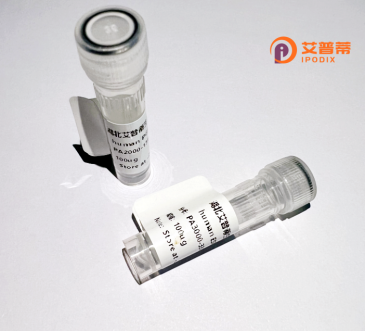
| 纯度 | >90%SDS-PAGE. |
| 种属 | Human |
| 靶点 | ARHGAP11A |
| Uniprot No | Q6P4F7 |
| 内毒素 | < 0.01EU/μg |
| 表达宿主 | E.coli |
| 表达区间 | 1-501aa |
| 氨基酸序列 | MWDQRLVRLALLQHLRAFYGIKVKGVRGQCDRRRHETAATEIGGKIFGVPFNALPHSAVPEYGHIPSFLVDACTSLEDHIHTEGLFRKSGSVIRLKALKNKVDHGEGCLSSAPPCDIAGLLKQFFRELPEPILPADLHEALLKAQQLGTEEKNKATLLLSCLLADHTVHVLRYFFNFLRNVSLRSSENKMDSSNLAVIFAPNLLQTSEGHEKMSSNTEKKLRLQAAVVQTLIDYASDIGRVPDFILEKIPAMLGIDGLCATPSLEGFEEGEYETPGEYKRKRRQSVGDFVSGALNKFKPNRTPSITPQEERIAQLSESPVILTPNAKRTLPVDSSHGFSSKKRKSIKHNFNFELLPSNLFNSSSTPVSVHIDTSSEGSSQSSLSPVLIGGNHLITAGVPRRSKRIAGKKVCRVESGKAGCFSPKISHKEKVRRSLRLKFNLGKNGREVNGCSGVNRYESVGWRLANQQSLKNRIESVKTGLLFSPDVDEKLPKKGTFTYYC |
| 分子量 | 81.51 kDa |
| 蛋白标签 | GST-tag at N-terminal |
| 缓冲液 | 冻干粉 |
| 稳定性 & 储存条件 | Lyophilized protein should be stored at ≤ -20°C, stable for one year after receipt. Reconstituted protein solution can be stored at 2-8°C for 2-7 days. Aliquots of reconstituted samples are stable at ≤ -20°C for 3 months. |
| 复溶 | Always centrifuge tubes before opening.Do not mix by vortex or pipetting. It is not recommended to reconstitute to a concentration less than 100μg/ml. Dissolve the lyophilized protein in distilled water. Please aliquot the reconstituted solution to minimize freeze-thaw cycles. |
1. **"ARHGAP11A promotes cell migration and invasion by regulating RhoA activity in cancer cells"**
- **作者**: Yamada et al. (2019)
- **摘要**: 研究发现ARHGAP11A通过抑制RhoA的GTP酶活性,增加其激活状态,从而增强肿瘤细胞的迁移和侵袭能力,与癌症转移相关。
2. **"ARHGAP11A interacts with the mitotic spindle and regulates cell division"**
- **作者**: Vicente-Manzanares et al. (2020)
- **摘要**: 揭示ARHGAP11A在有丝分裂期间与纺锤体结合,调控细胞分裂进程,其缺失导致染色体排列异常和分裂延迟。
3. **"Role of ARHGAP11A in neuronal development and synaptic plasticity"**
- **作者**: Heng & Chua (2021)
- **摘要**: 在小鼠模型中,ARHGAP11A通过调控Cdc42信号通路影响神经元树突发育和突触可塑性,可能与神经发育疾病相关。
4. **"ARHGAP11A as a prognostic biomarker in colorectal cancer"**
- **作者**: Lee et al. (2022)
- **摘要**: 基于临床数据,ARHGAP11A在结直肠癌中高表达,与患者预后不良相关,提示其作为潜在治疗靶点的价值。
每篇文献涵盖不同研究方向(癌症机制、细胞分裂、神经功能、临床预后),突出ARHGAP11A在Rho GTP酶调控中的多功能性。
ARHGAP11A (Rho GTPase-activating protein 11A) is a member of the RhoGAP family, which regulates Rho GTPases—key molecular switches controlling cytoskeletal dynamics, cell migration, and proliferation. This protein contains a conserved RhoGAP domain that inactivates RhoA and Cdc42 by accelerating their GTP hydrolysis, alongside structural motifs like PH domains or coiled-coil regions that mediate subcellular localization and protein interactions. Functionally, ARHGAP11A is implicated in neurodevelopment, where it may influence neural progenitor expansion and cortical organization, though its paralog ARHGAP11B is more strongly linked to evolutionary brain expansion. In cancer, ARHGAP11A dysregulation correlates with tumor progression; overexpression has been observed in gliomas, breast cancers, and colorectal carcinomas, potentially driving invasiveness by modulating epithelial-mesenchymal transition (EMT) or chromosomal instability. It also interacts with signaling pathways like Wnt/β-catenin and MAPK, suggesting roles in cell cycle control and apoptosis. Recent studies highlight its involvement in mitochondrial dynamics and metabolic reprogramming, adding layers to its cellular functions. Despite these advances, ARHGAP11A's precise mechanisms remain partly elusive, necessitating further research to explore its therapeutic potential as a biomarker or target in neurological disorders and oncology.
×